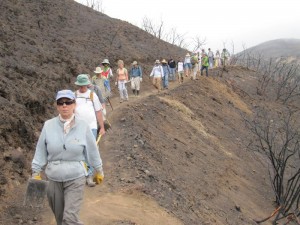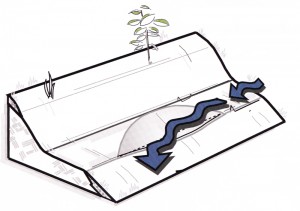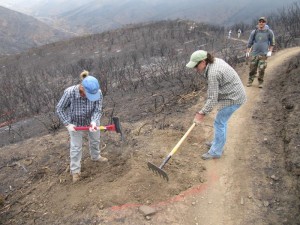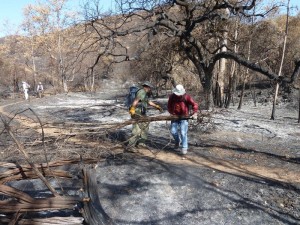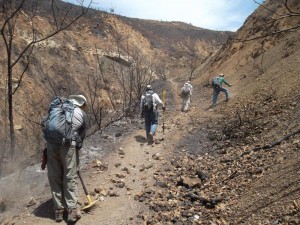This past Saturday, about 30 volunteers from CORBA, North Ranch Mountain Bikers, Girls Gone Riding, DirtChix, the Santa Monica Mountains Trails Council, the Ventura County Trail Runners and others came together at the top of the Guadalasca singletrack in Pt Mugu State Park to groom the trail after it had been levelled by a small bulldozer, fondly known as a Sweco.

The huge rut in front of the Sweco is filled in behind it.
As explained in our previous blog, State Parks has wanted for some time to fix the huge ruts and drainage problems on Guadalasca. The recent Springs Fire provided added incentive and also opportunity. Incentive came because unless something was done, rainwater would race down the denuded hillsides, carrying ash and mud with it, run onto the trails and then down it, futher erroding the already deep ruts, and also clogging it with crud. Opportunity came from the lack of brush along the trail edge, and overgrowing it, that normally impedes treadwork, and by the eagerness of volunteers to pitch in to help repair the trail and protect it from long-term damage as a result of the fire. On Wednesday and Thursday of last week, Dale Skinner, hands-on head of trail maintenance for State Parks in the Santa Monica Mountains, used the Sweco to push down the berm (the hump on the outside edge of the trail that keeps water from running off) and fill in the huge rut. He also pushed large rocks off the trail.
The Sweco leaves the trail generally level, but very loose and rough. Also there are a number of rocks of various sizes mixed in with the loose dirt. To finish the trail, any remaining berm must be removed, rocks larger than walnuts are swept off the trail, and the surface is sloped outwards so water will run across it and off, rather than down it. On Saturday, the volunteers along with Dale and two other State Parks staff, carpooled and caravanned to the top of Hell Hill, then hiked the 1.3 miles to the top of the singletrack section where work would begin.

- Workers at the front of the line rough in the new surface from how the Sweco left it
We broke into four groups, each of which occupied about 20-30′ of the trail. The leading group fixed the biggest problems, the last group made sure the trail was in as good condition as it could be, and the two intervening groups sequentially improved the trail as they went. Every 10-15 minutes, the groups shifted down so that each one was working where the group in front of it had been, and the leading group had fresh trail to address.
The result was basically an assembly line of trail improvement, with raw Sweco’d trail and the start, and smooth, flat and fairly well packed trail at the end.
When we got to a switchback, some of the workers broke off and helped build a stone wall to fortify it, and may have built special drainages to keep the water from running around it and down the trail.
We were scheduled to be back at the cars by 3:00 pm, which meant we needed to finish work on the trail by about 1:30 so we would have time to get back. Dale had Sweco’d about 0.7 miles of the singletrack, but by 1:15 we still had a couple hundred feet to finish. We didn’t have time for that, so instead we pulled down as much berm as possible so rainwater would be able to get off the trail. (We don’t know when we’ll get a chance to work on this trail again other than it won’t be until the fall at the earliest.)

The newly finished trail
The trail was amazingly improved after we had been down it, compared to how the Sweco left it, but still it was somewhat loose. Fortunately, the nature of the dirt there is that it packs down very quickly and the couple dozen mountain bikers who rode by as we were working helped a lot to pack it down. The next day it was packed well enough that a good biker could ride up it without much difficulty, so it should only take a couple of weekends of riders to pack it down to about 90% of normal.
After we got back to the cars, CORBA had their customary gift give-away to show appreciation to the volunteers who donated their time to help fix the trail, and then about a dozen of us headed to Magoos in Newbury Park for CORBA’s thank-you lunch.
You can view the trail crew at work and thank-you activities afterwards in our Guadalasca trailwork photo gallery.
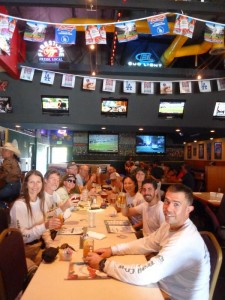
Lunch at Magoos
There is no question that all the volunteers had a good time working on the trails and recognized that it was in much better shape when we left it than before the Sweco went down it. For many volunteers, this was the first time they had done any trailwork, and they were surprised by how much fun it was and how much the group accomplished, and were delighted to have the chance to give back to the trails they use every week.
CORBA and the other groups would like to extend a super “Thank-You” to the volunteers who came out to help – you deserve a great big pat on the back!



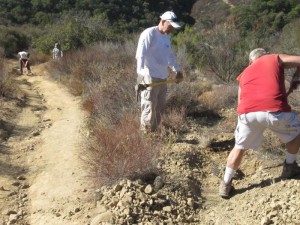
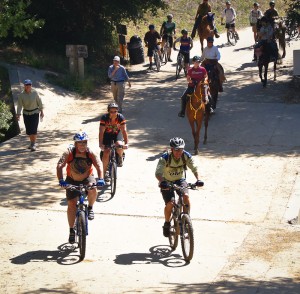


 Join CORBA and the Santa Monica Mountains Trails Council as we fix up the Backbone Trail near Latigo Canyon Road. We’ll be doing treadwork, clearing silt out of the drainages and possibly building some new ones. Our work on Saturday will help keep the water off the trail and prevent the ruts from getting bigger and swallowing the trail!
Join CORBA and the Santa Monica Mountains Trails Council as we fix up the Backbone Trail near Latigo Canyon Road. We’ll be doing treadwork, clearing silt out of the drainages and possibly building some new ones. Our work on Saturday will help keep the water off the trail and prevent the ruts from getting bigger and swallowing the trail!



